

Timeline.jpg (JPEG Image, 1499 × 632 pixels) - Scaled (68%) Renaissance 1300 to 1600. Queen Elizabeth I - Biography - Queen - Biography.com. Elizabeth I was the long-ruling queen of England, governing with relative stability and prosperity for 44 years.
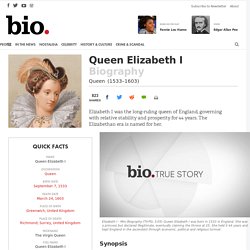
The Elizabethan era is named for her. Synopsis Queen Elizabeth I was born on the September 7, 1533 in Greenwich England. She was a princess but declared illegitimate through political machinations. She eventually claimed the throne at the age of 25 and held it for 44 years, keeping England in the ascendant through wars, and political and religious turmoil. Early Life Elizabeth I, perhaps England's most famous monarch, grew up in complex and sometimes difficult circumstances. Elizabeth was raised much like any other royal child.
Elizabeth once again found herself embroiled in political intrigue after Edward's death in 1553. Even though Elizabeth supported Mary in her coup, she was not free from suspicion. While she was soon released, Elizabeth's life was firmly in her sister's hands. Advertisement — Continue reading below War and Peace. Nicolaus Copernicus - Biography - Mathematician, Astronomer, Scientist - Biography.com. Astronomer Nicolaus Copernicus identified the concept of a heliocentric solar system, in which the sun, rather than the earth, is the center of the solar system.
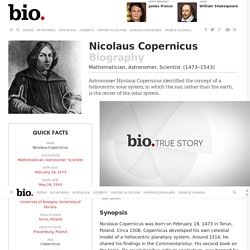
Synopsis Nicolaus Copernicus was born on February 19, 1473 in Torun, Poland. Circa 1508, Copernicus developed his own celestial model of a heliocentric planetary system. Around 1514, he shared his findings in the Commentariolus. His second book on the topic, De revolutionibus orbium coelestium, was banned by the Roman Catholic Church not long after his May 24, 1543 death in Frauenburg, Poland. Section 6 – Conclusion: The Effects of the Age of Exploration. Put text in RED that you think should be removed, and put in (parentheses) why you think it should be removed/edited.
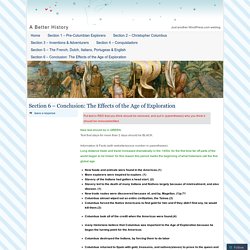
New text should be in GREEN. Text that stays for more than 2 days should be BLACK. Information & Facts (with website/source number in parentheses): HIST201-3.1.1-EuropeanExplorationIntro-FINAL. How was the world changed by the Age of Exploration? - Zach Schiffman's Captain's (B)log. Slavery and the Triangular Trade After the New World was discovered by the Europeans, more plants and crops were discovered as well.
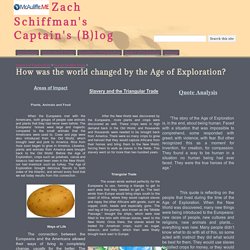
These crops were in high demand back in the Old World, and thousands and thousands were needed to be brought back from America. There were so many crops to grow and harvest that they would capture Africans from their homes and bring them to the New World, forcing them to work as slaves in the fields. This slavery went on for more than two hundred years. Triangular Trade The ocean winds worked perfectly for the Europeans to use, forming a triangle to get to each area that they needed to get to.
Effects of European Colonization: Christopher Columbus and Native Americans. Impacts of the Reformation. Renaissance Timeline Video. Impacts of the Renaissance. What were the major influences of the Italian Renaissance that changed art and religion of the time? - Homework Help. The beginning of the Renaissance in the mid-fourteenth century was marked by a turn from medieval life and values dominated by the Church toward the philosophical principles of humanism.
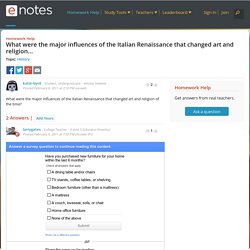
The major influences of the Italian Renaissance that changed art and religion were the questons being asked by scientist/artists like Leonardo DaVinci; writer, Francesco Petrarch, often known as the founder of humanism and scientists such as Copernicus and Newton who discovered mathematical relationships between objects and questioned known "religious" explanations for objects in space etc. The Italian Renaissance was a period of looking back into the classical age of the Greco-Roman period of art, form and philosophy. Writers valued classical philosophy of Plato, Aristotle and Socrates over the more current schools of thought. Art works were primarily sponsored by rich and the Church. The Influence of the Renaissance. The historical period known as the Renaissance spans from about the 15th to 17th centuries.

‘Renaissance’ means ‘re-birth’ and during this time Europe left behind the fixed ideas of the Middle Ages and created the beginnings of the modern world as we know it. The civilisations of ancient Greece and Rome were rediscovered, inspiring an interest in Classical learning which challenged medieval beliefs and ideas. The population was becoming wealthier which led to an increase in trade and travel and the spread of new ideas. The rise in prosperity also generated an interest in education, supported the flourishing of the arts and promoted scientific discoveries and new inventions. Perhaps the most important of these was the printing press (see image to the right) which enabled books to be printed rather than hand-written, and allowed the distribution of information to a much wider audience than ever before, further fuelling the clamour for more knowledge.
Renaissance art. All about the Renaissance Part 01 Historical Background Beginnings and Art. The Renaissance: Was it a Thing? - Crash Course World History #22. The Age of The Renaissance. KS3 Bitesize History - The Reformation : Revision. The Reformation. The Renaissance. The Renaissance Throughout the history of mankind, human technology and culture has experienced many advancements and setbacks.
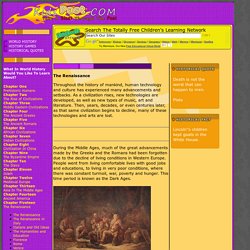
As a civilization rises, new technologies are developed, as well as new types of music, art and literature. Then, years, decades, or even centuries later, as that same civilization begins to decline, many of these technologies and arts are lost. During the Middle Ages, much of the great advancements made by the Greeks and the Romans had been forgotten due to the decline of living conditions in Western Europe. People went from living comfortable lives with good jobs and educations, to living in very poor conditions, where there was constant turmoil, war, poverty and hunger. The Dark Ages lasted for hundreds of years, as many generations of individuals lived and died in these terrible conditions.
History: Renaissance for Kids. Back to History for Kids.

The Renaissance. The Renaissance The Renaissance was a time of rebirth.

Europeans experienced a reawakening of interest in the classics--government, literature, art, and thought. It was a time of experimentation. It was a time of religious upheaval. And it was a time of war. Leonardo da Vinci Leonardo was one of the most influential men who ever lived. The Renaissance for kids - Common Core. About 1450, European scholars became more interested in studying the world around them.

At the same time, European artists produced work that was more true to life. And European ships set sail to explore new lands. This new age in Europe was eventually called "the Renaissance", a French word that means "rebirth. " advertisement. Renaissance Facts and Information for Kids. The Italian Renaissance and Italy's Transformation - Video & Lesson Transcript. Renaissance. Renaissance. Renaissance Time! Leonardo DaVinci. Renaissance Time! Italian Renaissance Fashion. Renaissance Life. A characteristic of the daily Renaissance life was its great simplicity, even among the rich. In the palace of the Medici, the ordinary hospitality consisted in the offer of wine and chestnuts! Life in Italy During the Renaissance. The Renaissance or rebirth began in Italy at the end of the fourteenth century and became an era of many cultural and architectural achievements in Europe.
The Renaissance first began in Tuscany and was centered on the republics of Siena and Florence after the decimation left in the wake of the Black Death. The end of the Renaissance period marked the transition of the continent from medieval to the early modern era in Europe. The term Renaissance itself is quite modern, since it began to be used by historians only in the 19th century. Later, it also had a great impact on the Republic of Venice and would also spread towards Rome. Family_life_during_the_renaissance.pdf. History for Kids: How did the Renaissance start? History >> Renaissance for Kids The Renaissance is generally considered to have started in Florence, Italy around the years 1350 to 1400. Renaissance for Kids: Daily Life. The Great Age of Exploration 1400 1550. A History of the Age of Exploration. Renaissance for Kids: Age of Exploration and Discovery. All About Explorers.
Famous Explorer Facts and Information for Kids. Famous Explorer Biographies. Explorers-in-Residence from National Geographic: Highlights some of the world of today's prominent explorers and scientists. Famous Space Explorers: Quick facts, photos, and information about their space exploration National Geographic: Explorers A-Z: Explorers are listed in alphabetical order with a links to websites with facts about each explorer Explorers-EnchantedLearning.com: Brief biographical information on famous explorers; Search alphabetically or by date or continent PBS: The Conquistadors (Cortes, Pizarro, Orellana, Cabeza de Vaca): Historical facts, timeline.
Explorers Maps, Activities, Biographies and More for Kids « Explorers and Explorations. Explorers. Exploration and Expansion.